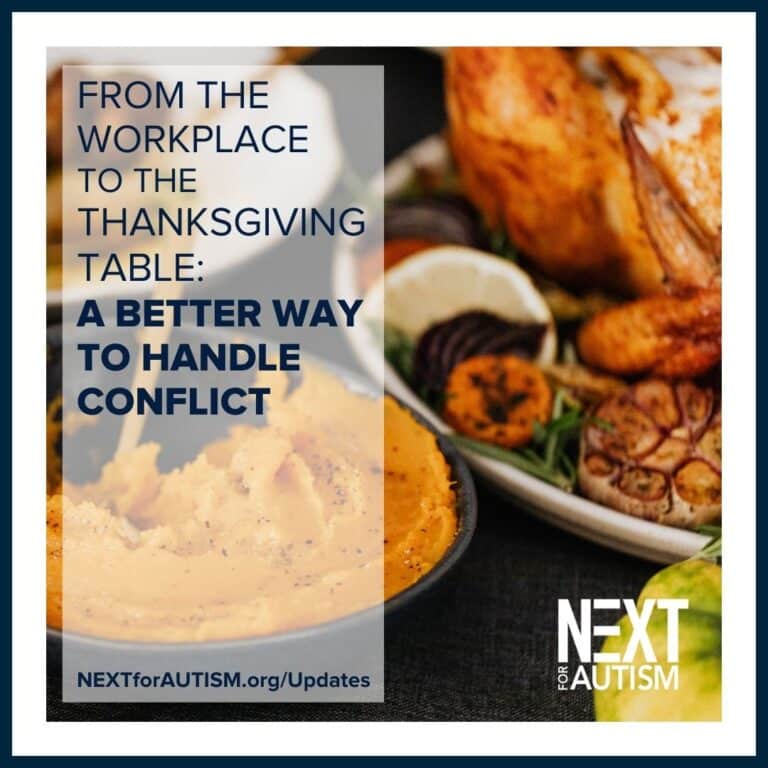How To Stay In Touch With A Sibling With Autism From Afar
Andrea Bennett, OTD, OTR/L, Manager of Program Development at NEXT for AUTISM, shares tips from her experience as a sib.
For any sibling, leaving home for college, work, or a new life can be a challenging adjustment that is layered with emotions. This is especially the case for siblings of individuals living with autism. Like others going through this life change, we and our siblings with autism experience feelings of loss, longing, and nostalgia. In addition, for those who’ve provided hands-on help to our families, there’s the added guilt of not being there for our brother or sister, of leaving our parents with less support, of thinking mainly of our own needs, and of missing out on important events and memories.
Having lived away from home for about 8 years, I know these challenges and emotions all too well. My brother is a big part of my life, and I, his. Our relationship is different from what you might expect of a typical sibling relationship. For example, we don’t share personal secrets or intimate details of our lives. Still, each of us occupies a significant place in the other’s life. When we lived together, we didn’t TALK to each other intimately, but we DID a lot together—going out, going to family events, going to the grocery store, and just engaging in daily life together. This makes it more challenging to maintain our relationship from afar. However, I’m happy to report that it is possible! I’ve had to get creative and learn how to have meaningful conversations more regularly, but it’s been well worth the effort and added a new level of intimacy to our relationship. Here are some tricks that I’ve put to use, one sibling to another:
- Explain why you’re moving and what you're doing there.
- Use visuals, a social narrative, or just have a conversation.
- Make sure to mention how you will stay in contact, that you love them, and that you will visit or take special trips together.
- They may be curious as to why you’re leaving and they’re not. Explain that some people make the choice to move when they’re adults, but that it's a big decision and different people are ready to move at different ages and times in their lives.
- Have a matching picture of the two of you in each other’s rooms.
- There’s nothing like a favorite picture that you can look at daily to remind you of your family member and feel connected to them!
- It also gives you a topic to talk about—“I saw your picture this morning and wanted to say I love you,” or “Is that picture of us at Disney still up in your room? What was your favorite part of that trip?”
- Figure out what forms of communication work best for both of you.
- Some options are Facebook Messenger, What’sApp, Google Chat, Facetime, a good old-fashioned phone call, or all of the above.
- Video and voice messages can be very helpful, especially for those who may not use spoken language as their primary way of communicating. They also give your sibling the option of replaying the message when they’re missing you. Seeing you or hearing your voice may provide a source of comfort during their day.
- Include parents and caregivers so that they can help facilitate the checking of messages or having your sibling send you check-ins.
- Calendar a Regular Time.
- Set up a weekly video chat or phone call. Even if you have to reschedule, it means you're both on each other's minds.
- Make a family group chat.
- This helps everyone stay in touch and can also help your sibling (or your parents/other family member) share what s/he has been up to, which in turn helps you better facilitate one-on-one conversations with your sibling.
- Ask pointed questions to draw out more information or ask about an event. My brother’s usual response to “How was your day?” is “wonderful” or to “Anything special happen this week?” is “I went to Publix (our local grocery store) and bought ___.” But if I know that he went to the movies with a friend, I can ask, “Have you been to the movies lately?” or “Did you do anything fun with a friend this week?” This gives him something concrete to speak about.
- Make a list of common interests or things you enjoy doing together.
- Figure out if there's a way you can still engage in the activity together from afar. If not, make a plan to do so together the next time you visit.
- My brother and I enjoy music and singing together, especially classic oldies, Eydie Gorme, and musicals (especially Rent). I might post one of our favorite songs on his Facebook wall or we might decide to break out into song over video chat or a phone call.
- Try scheduling the same activity at the same time in your separate locations and send each other pictures or videos while you’re doing the activity.
- Always have something you both can look forward to.
- Whether that's an upcoming visit, phone call, or family vacation. In all long-distance relationships, it helps to know that there's something positive and some contact coming soon. For my brother, it's the next time we’ll see each other. He always reminds me, "Andrea, I will get to see you on October 4th when you come to visit me at my home," and from the time I arrive, the follow up question, "Andrea, when will you be returning to Florida," is always on his mind.
- Remember that thing called mail!
- In this digital age, it's easy to forget how exciting it is to get mail or a package. Traveling? Send your sibling a postcard. Just want them to have a special week? Send them a care package with some of their favorite snacks or items of interest.
- Send special memorabilia or pictures.
- On some websites, you can take a photo and make something fun like a mug, tote bag, or phone case. One of our family favorites is the picture puzzle. This is a fun token your sib can use and a way to facilitate thinking about you. (Make sure to select puzzle piece size based on your sibling’s ability.)
*A version of this article, entitled “From One Sibling to Another: Tips for Maintaining a Sibling Relationship from Afar,” was published in The Autism Notebook Magazine, Aug/Sept 2018.








Leave a Reply